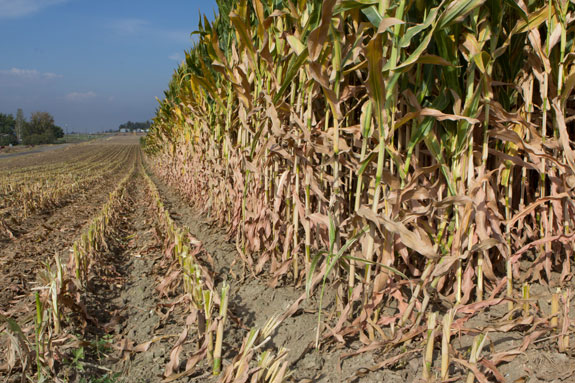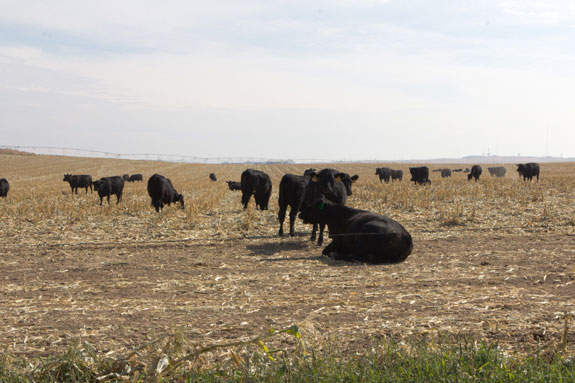And, it is an economical feeding option worth considering, says University of Nebraska ruminant nutritionist Aaron Stalker.
Stalker, who is based at the West Central Research and Extension Center in North Platte, reports that especially on irrigated cornfields cows can maintain bodyweight on the cornstalk residue that remains after combining – and no protein supplementation is needed when stocking rate is appropriate, nor is there a detrimental impact to the future yield of the field.
As testament to how well cows can do on cornstalk residue, Stalker cites one study that compared cows grazing cornstalks stocked at 1.5 AUM per acre without any supplemental feed to cows on winter range that were also being supplemented with two pounds per head per day of 32 percent crude protein range cake.
The cows performed equally, which Stalker says is an indication that cornstalks offer higher quality nutrition than winter range – and without the need for supplementation.

Calculate stocking rate
But Stalker says there are a few guidelines to follow if you plan to have your cattle graze cornstalks this fall or winter – starting with stocking rate.
“That’s the single most important consideration. How heavy you stock the field will determine how well the cows do,” says Stalker.
He explains that the corn grain is the most nutritious part of the plant, second is the husk and third in nutrient quality is the leaf. A cow can maintain her bodyweight if a portion of these plant parts are available for grazing, according to Stalker. The cobs and stem offer the lowest nutritive value and cows will begin to lose bodyweight if that is the only part of the plant available for grazing.
Stalker adds, “Producers need to recognize that the most nutritious parts of the corn plant are a small part of the residue. So, if you leave cattle on a field too long they will begin to lose weight.”
Cornstalk residue available for grazing – and the appropriate stocking rate – can be determined based on the corn grain yield of the field. As a rule of thumb, Stalker says an irrigated corn plant will produce about 16 pounds (dry matter) of leaf and husk – with about half of that available after harvest for grazing.
Stalker and his colleagues with the University of Nebraska’s West Central Research and Extension Center have developed an online calculator which uses corn grain yield as a factor for calculating stocking rates for grazing cornstalks.
The calculator can be used to estimate the number of animals (based on their size) and the number of grazing days per acre based on the corn yield. The calculator is available here.
Stalker says on average 1.5 AUMs (animal unit months) per acre is an appropriate stocking rate for irrigated corn. This would be equivalent to about 45 grazing days per acre.
He says often producers don’t do the calculations and stock their fields with a different stocking rate than what the cornstalk residue could actually sustain.
Supplementation not needed
Stalker says a frequent misconception with regard to grazing cornstalks is that supplementation is needed. However, research is showing that when the right stocking rate is determined, cows grazing cornstalks don’t need pampering.
Stalker shares data from a Nebraska study that compared pregnant cows on cornstalks that were supplemented with range cubes to pregnant cows on cornstalks that were not supplemented. He reports that there were no significant differences between the two cow groups in pregnancy rate or weaning weight and feedlot finishing data of the calves.
Stalker says, “If you feed supplement, the cow will gain more body condition, but our research suggests there is no economic or production benefit to supplementing cows on cornstalks if they are stocked at 1.5 AUMs per acre.”
Another misconception that landowners sometimes have about grazing cornstalk residues is the impact to subsequent corn yields, according to Stalker. He says, “A lot of farmers are concerned about that, but our research has found there’s no negative impact. And, in some instances, grazing can actually increase yield.”
Stalker reports that data from two studies – one in eastern Nebraska and the other in western Nebraska – do not indicate any reduction in subsequent grain yield after cornstalk residues were grazed. Compaction has also not been shown to be an issue, Stalker says.
Bottom line is this according to Stalker: “For the majority of corn acres, especially irrigated, we aren’t doing any harm if we remove residue, and we might be doing some good.”
However, he does caution that on dryland cornfields – especially highly erodible fields – grazing cornstalk residues may be detrimental to future yields because breaking up the residue allows for more moisture evaporation and runoff.
Stalker advises that depending on the field, it may not be a good idea to graze cornstalk residue if conserving soil moisture is important.

Other factors to consider
Additionally, Stalker suggests keeping the following factors in mind if you plan to have cows graze cornstalks this fall or winter:
Clean up grain spills before grazing. Stalker points out that if cows eat too much grain at one time, they could get acidosis. Fortunately, he adds that with today’s precision technology much less grain is left in the field than it was 20 years ago.
Graze any time after harvest. Stalker says studies have been done to measure nutrient content of leaves and husks right after harvest compared to late winter/early spring. He reports that the nutrient content does not change much during that time, so grazing cornstalk residue can be done any time in the fall or winter – so long as snow isn’t too much of a hindrance.
Be prepared for ice and/or stormy weather. Stalker notes that snow is not as big a problem as ice. He notes that cows can forage through a couple inches of snow without any problems or need for supplemental feed but adds, “As soon as the snow begins to crust or if ice accumulates the cattle cannot continue to forage. In this instance harvested forages should be fed.”
He explains, “A couple pounds of supplemental protein are not going to cut it if the cornstalks are frozen down. It’s a supplementation verses substitution issue. I recommend producers have a few bales of hay on hand to get through severe storms.”
Because snowfall is highly variable from year to year, Stalker advises producers to also consider the effects winter storms may have on the ability of electric fences to keep cattle on the cornfield.
Consider trucking costs. Stalker admits that trucking is always an issue, but says, “This year with the high hay prices, you can afford to haul your cows a long way.” The Corn Stalk Grazing Calculator available on the University of Nebraska website (referenced above) can also be used to calculate cattle transportation costs.
Find the calculator here or go to beef.unl.edu, select the “learning modules” tab and select Corn Stalk Grazing Calculator. ![]()
PHOTOS
Photos by Progressive Cattleman staff.







